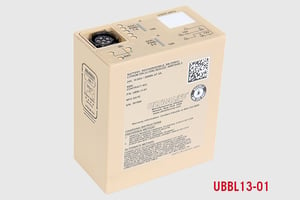Effective decontamination and sterilization of hospital wards and bathrooms is essential in reducing the risk of cross infection. This is especially important during the COVID-19 pandemic, when we consider that there are just 20 critical care beds per 100,000 people in the US. Here, we explore the vital role robotics play in sterilization and what to consider when choosing a power supply.
 The Centers for Disease Control and Prevention (CDC) published guidance for healthcare settings in Infection Prevention and Control Recommendations during the COVID-19 pandemic. In particular, patient isolation rooms must be terminally cleaned following each patient’s transfer or discharge from the hospital; including removing all detachable objects in the room and cleaning everything from the ceiling (lighting and air duct surfaces) down to the floor. It is a time consuming and, in light of the current pandemic, dangerous task.
The Centers for Disease Control and Prevention (CDC) published guidance for healthcare settings in Infection Prevention and Control Recommendations during the COVID-19 pandemic. In particular, patient isolation rooms must be terminally cleaned following each patient’s transfer or discharge from the hospital; including removing all detachable objects in the room and cleaning everything from the ceiling (lighting and air duct surfaces) down to the floor. It is a time consuming and, in light of the current pandemic, dangerous task.
A study from Duke Medicine showed that enhanced cleaning strategies, such as using portable ultraviolet (UV) machines, can kill drug and cleaning-resistant organisms and demonstrated that these techniques can make meaningful differences in patient outcomes. These UV light technologies have been used for decades in water and air purification, but combining them with autonomous robots is a recent — but much needed — development.
The robots emit UV-C light, a type of ultraviolet light that is not found on earth, unlike UV-A and UV-B which are well-known to cause sunburn. Therefore, viruses and bacteria are not immune to UV-C. When this type of ultraviolet light shines onto germs, it attacks their DNA, so they cannot infect another person.
To emit UV-C light, a typical sterilization robot incorporates a disinfection lamp with an accumulated intensity of 250 to 280 uv/cm2 and a coverage radius of six to eight metres. The lamp is connected to either a mains powered mobile cart on wheels, which staff have to move from room to room, or an autonomous mobile robot (AMR).
AMRs are similar to AGVs (automated guided vehicles) in a warehouse, autonomously navigating around buildings for most of the day, every day. They are therefore reliant on batteries as the main source of power. The power demands on the battery are particularly high due to the disinfection lamp, which may need to be recharged every few hours.
Therefore, AMR batteries are usually recharged in the same way that AGV batteries are. The robots are self-aware of how much power they have left and, when the battery is running low, they automatically navigate to a charging station to recharge.
Usually in AMRs, the battery is used as a ballast to keep the centre of balance low, but the weight must not be enough to inhibit mobility. This means that the strength and weight of the battery, as well as long run time and fast charge time are key requirements in this application. Traditionally, sealed lead acid (SLA) batteries have been used in applications with similar requirements.
Nowadays, however, original equipment manufacturers (OEMs) tend to favour replacing SLA batteries with Lithium Iron Phosphate (LiFePO4) alternatives, as they are three times lighter for the same energy. Available in a variety of weights, if ballast is a requirement, they can also offer higher energy than SLA if required. For example, Ultralife’s range of 12.8 V LiFePO4 batteries goes from a 1.10 Kg battery, offering 7.5 Ah (96 Wh) to a 13.90 Kg battery, offering 100 Ah (1.28 kWh).
 If voltages of up to 28.8 V are required, Ultralife’s legendary range of military 2590 rechargeable lithium-ion smart batteries may be better suited. When operating at this voltage, the UBBL13-01 can offer up to 10 Ah (288 Wh) at a weight of 1.38 Kg. Selected 2590 batteries, including the UBBL13-01, are also fully compliant with System Management Bus (SMBus) and Smart Battery System (SBS) specifications, which means they can be quickly integrated into compatible robots or smart chargers.
If voltages of up to 28.8 V are required, Ultralife’s legendary range of military 2590 rechargeable lithium-ion smart batteries may be better suited. When operating at this voltage, the UBBL13-01 can offer up to 10 Ah (288 Wh) at a weight of 1.38 Kg. Selected 2590 batteries, including the UBBL13-01, are also fully compliant with System Management Bus (SMBus) and Smart Battery System (SBS) specifications, which means they can be quickly integrated into compatible robots or smart chargers.
Both 2590 and LiFePO4 ranges encompass a diverse collection of batteries to allow robot manufacturers to select the voltage, weight and energy they need. This is not only an advantage to fully autonomous robots but also mains powered, mobile cart versions, which may use batteries to communicate data back to the end user’s computers (rather than powering the lamp itself).
Whilst we have covered the basic types of disinfection robot here, each manufacturer provides slight variations of features to differentiate from competitors. Ultralife recognizes this and can work closely with design engineers to understand how the battery and charger will function in their specific sterilization robot, to create a bespoke portable power solution.
UV-C robots play an important role in the fight against COVID-19, with studies suggesting that 99.9 per cent of coronaviruses can be killed when exposed to far-UVC light. Batteries fulfil the equally important functions of powering the robot or transmitting data back to the user. Therefore, selecting the battery that meets the robot’s power and weight requirements is vital to ensuring smooth and successful operation.



